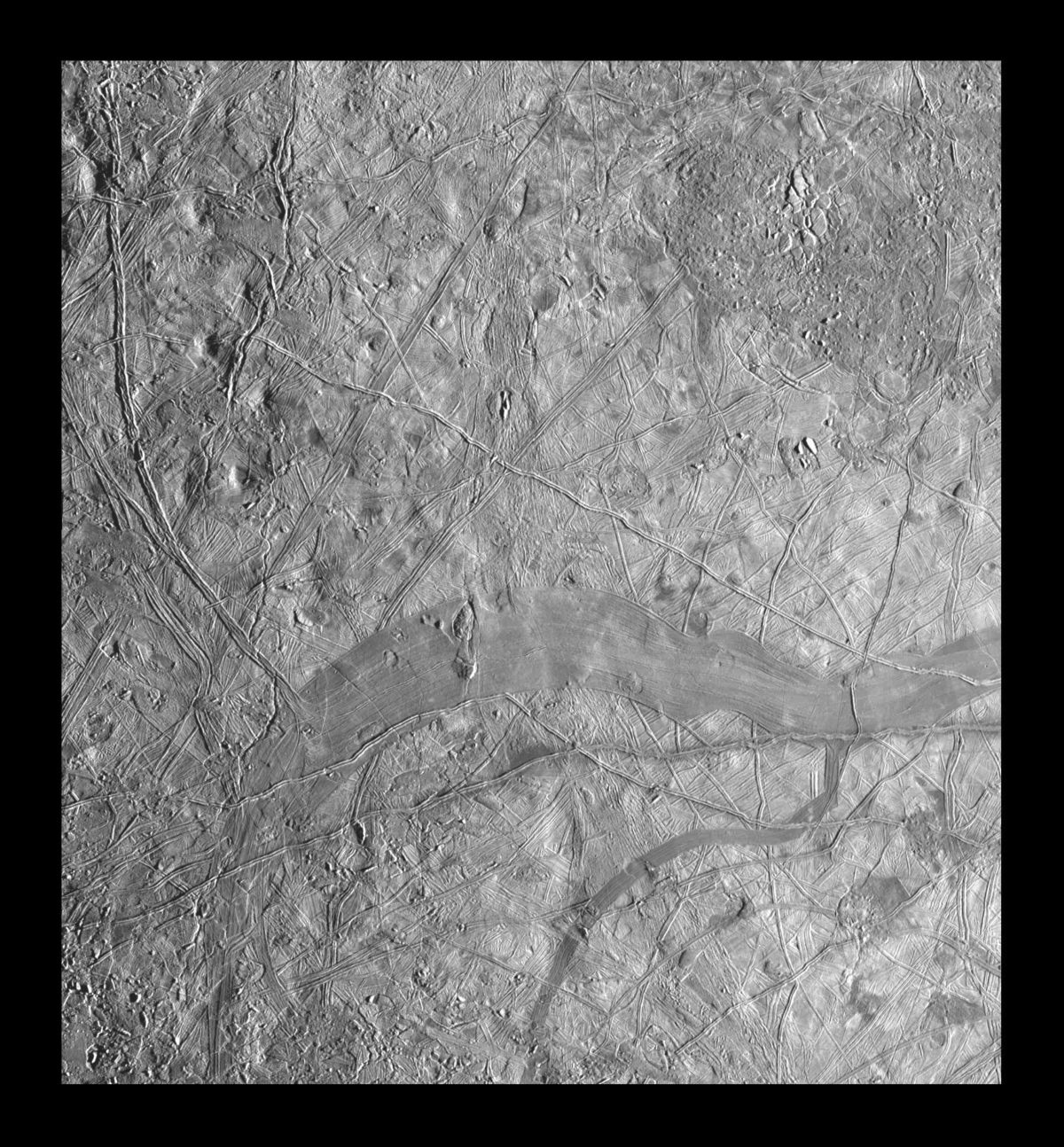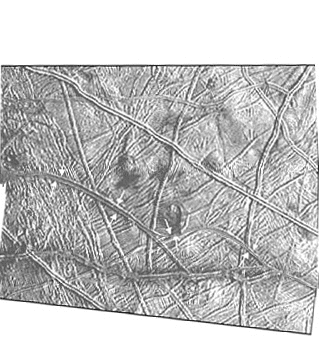Emily Lakdawalla • Mar 19, 2014
LPSC 2014: Plate tectonics on another world: Europa
We're about halfway through the 2014 Lunar and Planetary Science Conference and its relentless scientific sessions about geology on every solid-surfaced thing in the solar system, from planets to moons to meteorites. So far I think the most exciting work I've seen presented at this meeting is Simon Kattenhorn and Louise Prockter's work on solving a longstanding puzzle on Europa. Yesterday, Kattenhorn demonstrated that Europa may be only the second world we know of -- besides Earth -- where there is active plate tectonics. This is quite new work; it was presented for the first time at the American Geophysical Union meeting in December, and there's no peer-reviewed publication yet.
We know that Europa has a very youthful surface. There are only 41 named craters. Depending on how frequently you think the outer planet moons get hit by wandering comets, that means that globally, the surface is between 40 and 90 million years old, and there are no heavily cratered regions. So either Europa had some major event 40 to 90 million years ago that wiped out its whole surface and started it fresh, or Europa is experiencing global active geology that, on average, refreshes any spot on its surface once every 40 to 90 million years.
There is, of course, other evidence for activity on Europa in the form of criscrossing bands and grooves and other linear features that show that its ice shell is experiencing active geology. It can all be pretty confusing, and there's still debate on how some of Europa's most distinctive features formed, like its double ridges. But there is a kind of terrain that presented a puzzle that was easier to solve.
Europa has wide lanes of thinly grooved material that are called "bands." This picture contains one named Phaidra Linea:

You can demonstrate that many of these bands are places where the Europan crust has fractured and spread apart, with new crust being generated inside the band. Just take a pair of scissors to a Galileo image and you can reunite geologic features on opposite sides of the band.

These bands are interpreted to be places where there has been spreading and the generation of new crust on Europa. It's strikingly similar to mid-ocean ridges on Earth, where plates are spreading apart and new crust is being generated at the spreading ridges. Making new crust is exactly what we expect Europa to be doing if it has a youthful surface. There's a problem, though: Europa has to be removing, or at the very least, shortening, old crust to make way for this new crust being generated at spreading centers. But evidence for places where Europa removes crust has been really, really hard to find.
Earth accomplishes shortening or removal of old crust in two ways. Earth shortens its crust by folding it, which builds mountains, and also deforms the crust so much that it obliterates older geologic features. But that only accounts for a little of Earth's crustal removal. The main way Earth gets rid of old crust is by recycling it into the interior, at subduction zones. Cold, dense ocean crust dives downward and eventually gets incorporated into Earth's mantle. It's the familiar conveyor belt of plate tectonics: crust comes up at ridges and goes down at troughs and there's a circular flow in the mantle that brings material back up at the mid-ocean ridges. It operates quite quickly, geologically speaking; there's no ocean crust on Earth that's older than 270 million years old, and most of it is quite a bit younger.
Geologists have found some evidence for folds on Europa:

But these folds can't shorten the Europan crust by very much, not nearly enough to accommodate all the expansion at the bands. Which leads to the work that Kattenhorn presented yesterday. He and Prockter have identified a feature on Europa that they call "tabular bands." Performing the same kind of puzzle-piecing reconstruction work that demonstrates the spreading at Phaidra Linea, they showed that tabular bands are places where crust has disappeared at Europa.
I wish I had a good image to show you, but if these tabular bands and missing crust were obvious, they would've been noticed back in the late '90s when the spreading zones were discovered. Here is the figure from their abstract. It's common for the images from LPSC abstracts to be less than convincing, because the scientists are reserving the good stuff for when they are ready to submit their work to a peer-reviewed journal. This graphic shows you where the bands are, but doesn't really present the case for why you might think they are subduction zones.

With better images in his presentation, Kattenhorn outlined a list of seven lines of evidence that these tabular bands were subduction zones:
He concluded by saying that these features could have progressively removed all old cratered terrains, leaving Europa with only youthful crust. He mentioned that by recycling crust into the interior, you bring stuff from the surface into the interior. Europa's surface likely bears a lot of weird chemistry because its materials get attacked by all the charged particles in Jupiter's nasty radiation environment. So bringing crust down into the interior means you can potentially deliver surface materials, with all their interesting chemistry, to Europa's internal ocean. Which makes astrobiologists hoping to discover life on Europa happy.
His talk was followed by some good questions. Michael Bland wanted to know if they'd seen these features in other places. The answer was no, but mostly because they haven't worked on other parts of Europa yet, though they'd identified other candidate sites. Another questioner pointed out that volcanism that happens on Earth subduction zones is thought to happen because the diving plate carries water with it, which lowers the melting temperature of crustal rocks. On Europa, it's all water; what would make volcanoes on the overriding plate on Europa? Kattenhorn agreed with the question and said he couldn't explain why they would be there, he could only observe that they were there, making volcanic deposits 100 meters thick in places.
Plate tectonics and plumes. We need to get back to Europa, and map it properly!!
Support our core enterprises
Your support powers our mission to explore worlds, find life, and defend Earth. You make all the difference when you make a gift. Give today!
Donate

 Explore Worlds
Explore Worlds Find Life
Find Life Defend Earth
Defend Earth

